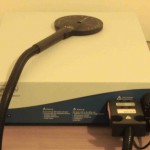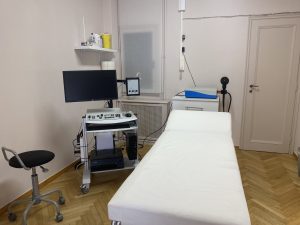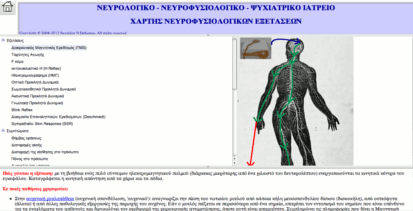- Transcranial Magnetic Stimulation
- Nerve Conduction Studies
- F Wave – H Reflex
- Electromyogram (EMG)
- Single Fiber Electromyogram (Single Fiber EMG)
- Visual Evoked Potentials (VEPs)
- Somatosensory Evoked Potentials – SSEPs
- Brainstem Auditory Evoked Potentials – BAEPs
- Cognitive Evoked Potentials (P300)
- Vestibular Evoked Myogenic Potentials – VEMPs
- Blink Reflex
- Repetitive Nerve Stimulation (Desmedt)
- Sympathetic Skin Response (SSR)
You can click on any of the tests above to read more details, or you use this interactive neurophysiology explorer:
Transcranial Magnetic Stimulation
Transcranial Magnetic Stimulation is useful in the diagnosis of:
- Cervical Myelopathy and Cervical Spondylosis: it detects cervical lesions of the spinal cord, caused by intervertebral disc hernias, spondylosis or other diseases. In the case of multiple lesions, TMS can help identify the one that is responsible for the neurological damage and that needs to be operated on. TMS complements cervical spine MRI and allows the follow up of the functional status of the spinal cord, post-operatively.
- In the case of Thoracic Lesions of the spinal cord, TMS can help determine whether a functional deficit exists and to decide whether surgical decompression is required.
- In the case of Multiple Sclerosis and allied Demyelinating diseases, TMS can be used to evaluate the functional status of the pyramidal tracts, which are responsible for voluntary movement, and to identify demyelinating lesions that are not clinically evident and cannot be seen in MRIs. The diagnosis of Multiple Sclerosis is often difficult, and needs to be supported by neurophysiological tests such as TMS, visual evoked potentials and somatosensory evoked potentials. If TMS identifies occult pyramidal lesions, then the probability of Multiple Sclerosis increases. If no such lesions are identified, then the probability of Multiple Sclerosis decreases.
- Amyotrophic Lateral Sclerosis, ALS: ALS is characterized by degeneration of both central and peripheral motor neurons. Cervical myelopathy, on the other hand, can often mimic ALS and needs to be excluded before the diagnosis of ALS can be made. This is an important step, since cervical myelopathy is a treatable condition. On the other hand, patients suffering from ALS may be incorrectly thought to suffer from cervical myelopathy, and might undergo unnecessary surgery. TMS can help in the differential diagnosis of ALS and cervical myelopathy, and to decide on appropriate treatment options.
- TMS is used to determine the prognosis of stroke, and in the treatment of Parkinson’s Disease, Migraine and Depression.
Sensory and Motor Nerve Conduction Studies
Sensory and Motor conduction velocities are required for the diagnosis of polyneuropathies. Polyneuropathies can be caused, among other things, by diabetes mellitus and kidney failure. Some polyneuropathies are inflammatory or hereditary.
- In entrapment neuropathies, peripheral nerves are lesioned in upper or lower limb sites where they are most vulnerable. Their entrapment can cause numbness, pain and/or weakness. The most common entrapment neuropathy is the Carpal Tunnel Syndrome.
- Conduction velocities are useful in the diagnosis and localization of nerve or plexus lesions, caused by injury.
F Wave – H Reflex
F wave and H Reflex complement conduction velocities in the evaluation of peripheral nerves.
Electromyogram (EMG)
Electromyography (EMG) is useful in the diagnosis of:
- Spinal root lesions: These are often caused by herniation of intervertebral discs, usually in the lumbar or cervical spine. Spinal root lesions can cause pain, numbness and/or weakness.
- Myopathy: Myopathies have multiple causes. Viral and microbial infections, autoimmune diseases and malignancies (cancer) are important causes. Some myopathies are hereditary, while others are caused by drugs.
- Neuropathy: here EMG complements nerve conduction velocities, adding important information to the diagnosis.
- Amyotrophic Lateral Sclerosis, and other motor neuron diseases.
- Injuries of the peripheral nerves and plexuses.
Single Fiber Electromyogram (Single Fiber EMG)
Single Fiber EMG is useful in the diagnosis of Myasthenia Gravis, which can present as eye lid ptosis or generalized weakness. Single Fiber EMG is also useful in the diagnosis of a range of related myasthenic syndromes.
Visual Evoked Potentials – VEPs
Visual Evoked Potentials are an important test for the diagnosis of optic nerve pathologies. These can be isolated optic or retrobulbar neuritides or can occur in the course of systemic diseases, such as Multiple Sclerosis. Patients suffering from Multiple Sclerosis often experience occult optic or retrobulbar neuritis, which may go unnoticed. Visual Evoked Potentials detect such incidences, thus offering additional information that can help establish a diagnosis of Multiple Sclerosis. Optic nerves can also be involved in several autoimmune, metabolic and hereditary diseases.
Somatosensory Evoked Potentials – SSEPs
Somatosensory Evoked Potentials are used to evaluate the integrity of the sensory tracts. Like the Visual Evoked Potentials, they can detect occult lesions of the sensory tracts that may have gone unnoticed, thus helping to established a diangosis of Multiple Sclerosis.
Brainstem Auditory Evoked Potentials – BAEPs
Brainstem Auditory Evoked Potentials evaluate the functional integrity of the neural circuits that are responsible for hearing. They are useful in detecting deafness of central original, i.e. that can be caused by brain lesions, such as Stroke and Multiple Sclerosis. They can assist the diagnosis of Multiple Sclerosis by detecting occult lesions of the auditory tracts.
Cognitive Evoked Potentials (P300)
Cognitive Evoked Potentials comprise a neurophysiological test that evaluates the ability of a person to concentrate. They are distorted in diseases that affect concentration, such as certain psychiatric diseases and delirium.
Vestibular Evoked Myogenic Potentials – VEMPs
VEMPs are useful in disorders of hearing and balance, where they test the integrity of the vestibular system (vestibular nerve, vestibular nuclei and more).
Blink Reflex
The Blink Reflex evaluates the functional integrity of the sensory and certain motor nerves of the face. It is useful in the detection of lesions of the facial nerve (such as facial nerve palsy or Bell’s palsy), of the trigeminal nerve, and of the brainstem, such as in the context of Stroke, Multiple Sclerosis or other pathological conditions.
Repetitive Nerve Stimulation (Desmedt)
They are useful in the diagnosis of Myasthenia Gravis and of other Myasthenic Syndromes.
Sympathetic Skin Response (SSR)
Evaluates the functional integrity of the autonomic nervous system. The Sympathetic Skin Response is useful, among other things, in the diagnosis of Parkinson Plus Syndromes, and in the evaluation of the autonomic nervous system in Parkinson’s disease.



